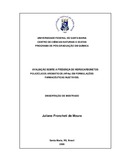| dc.creator | Moura, Juliane Froncheti de | |
| dc.date.accessioned | 2010-01-12 | |
| dc.date.available | 2010-01-12 | |
| dc.date.issued | 2009-09-10 | |
| dc.identifier.citation | MOURA, Juliane Froncheti de. EVALUATION ON PRESENCE OF POLYCICLIC AROMATIC
HYDROCARBONS (HPAs) IN INJETABLE PHARMACEUTICAL. 2009. 136 f. Dissertação (Mestrado em Química) - Universidade Federal de Santa Maria, Santa Maria, 2009. | por |
| dc.identifier.uri | http://repositorio.ufsm.br/handle/1/10455 | |
| dc.description.abstract | Polyciclic Aromatic Hydrocarbons (PHAs) are a family of compounds which contain two or more condensed aromatic rings. These substances, including the oxygenate and nitrogenate derivates, are widely spread in the
environment, being found in several locations. A great number of PAHs, with similar structural and physicochemical characteristics, which are known by their
carcinogenic and mutagenic properties, are distributed in the environment. In this study the presence of PAHs in carbon black, rubbers used as closure in medication containers, as well as in some pharmaceutical formulations (amino acid and lipid solutions for parenteral nutrition and some injectable drugs) was investigated by high performance liquid chromatography. The origin of PAHs in
rubbers and in pharmaceutical products stored in containers with rubber closures is the carbon black used as pigment. For the analysis, PAHs were extracted from the carbon black itself and from different types of rubber closures with acetone. The determination in the pharmaceutical formulations demanded a previous solid phase extraction of the PAHs, using polystyrene columns. The extraction was optimized with individual solution of each formulation investigated. The results showed that all analyzed rubbers were contaminated by PAHs. The levels were within 0.12 mg g-1 for Benzo(a)Pyrene and 5.64 mg
g-1 for Benzo(ghi)Perylene. Among the pharmaceutical products, amino acid solutions presented levels between 0.02 mg L-1 for Benzo(a)Pyrene and 0.21 mg L-1 for Pyrene, and lipid emulsions 0.07 mg L-1 and 0.19 mg L-1 for the same PAHs. Among the injectables, the contamination ranged between 0.06 mg L-1 and 0.031 mg L-1 for the Benzo(a)Pyrene. | eng |
| dc.description.sponsorship | Coordenação de Aperfeiçoamento de Pessoal de Nível Superior | |
| dc.format | application/pdf | por |
| dc.language | por | por |
| dc.publisher | Universidade Federal de Santa Maria | por |
| dc.rights | Acesso Aberto | por |
| dc.subject | Hidrocarbonetos policíclicos aromáticos | por |
| dc.subject | Cromatografia | por |
| dc.subject | Medicamentos | por |
| dc.title | Avaliação sobre a presença de hidrocarbonetos policíclicos aromáticos (HPAs) em formulações farmacêuticas injetáveis | por |
| dc.title.alternative | Evaluation on presence of polyciclic aromatic hydrocarbons (HPAs) in injetable pharmaceutical | eng |
| dc.type | Dissertação | por |
| dc.description.resumo | Os hidrocarbonetos policíclicos aromáticos (HPAs) constituem uma família de compostos caracterizada por possuírem 2 ou mais anéis aromáticos condensados. Estas substâncias, bem como seus derivados nitrados e oxigenados, têm ampla distribuição e são encontrados como constituintes de
misturas complexas em todos os compartimentos ambientais. Existe uma imensa variedade de HPAs no meio ambiente, grande parte deles possuindo características estruturais e propriedades muito similares, são conhecidos por
suas propriedades carcinogênicos e/ou mutagênicos. Neste estudo foi investigado a presença de HPAs no negro de fumo, borrachas utilizadas como tampas de frascos de medicamentos, bem como algumas formulações farmacêuticas (aminoácidos e soluções lipídicas para nutrição parenteral e
alguns medicamentos injetáveis) por cromatografia líquida de alta eficiência. A origem dos HPAs nas borrachas e em produtos farmacêuticos está no uso do negro de fumo, como pigmento. Para as análises, os HPAs foram extraídos do
negro de fumo e de diferentes tipos de tampas de borrachas com acetona. A determinação de HPAs nas formulações farmacêuticas exigiu prévia extração em fase sólida, usando colunas de poliestireno. As extrações foram otimizadas
com soluções individuais de cada formulação investigada. Os resultados mostraram que todas as amostras de borrachas analisadas estavam contaminadas por HPAs. Os níveis foram entre 0,12 mg g-1 para Benzo(a)Pireno e 5,64 mg g-1 para Benzo(g,h,i)Perileno. Entre os produtos farmacêuticos, as soluções de aminoácidos apresentaram níveis entre 0,02 mg
L-1 para Benzo(a)Pireno e 0,21 mg L-1 para Pireno, e emulsões lipídicas 0,07 mg L-1 e 0,19 mg L-1 para os mesmos HPAS. Entre os injetáveis, a contaminação esteve entre 0,06 mg L-1 e 0,03 mg L-1 para o Benzo(a)Pireno. | por |
| dc.contributor.advisor1 | Nascimento, Denise Bohrer do | |
| dc.contributor.advisor1Lattes | http://lattes.cnpq.br/9817093263802769 | por |
| dc.contributor.referee1 | Rosa, Marcelo Barcellos da | |
| dc.contributor.referee1Lattes | http://lattes.cnpq.br/0308293154958870 | por |
| dc.contributor.referee2 | Thiesen, Flavia Valladão | |
| dc.contributor.referee2Lattes | http://lattes.cnpq.br/1047475348538696 | por |
| dc.creator.Lattes | http://lattes.cnpq.br/4872119199805529 | por |
| dc.publisher.country | BR | por |
| dc.publisher.department | Química | por |
| dc.publisher.initials | UFSM | por |
| dc.publisher.program | Programa de Pós-Graduação em Química | por |
| dc.subject.cnpq | CNPQ::CIENCIAS EXATAS E DA TERRA::QUIMICA | por |


